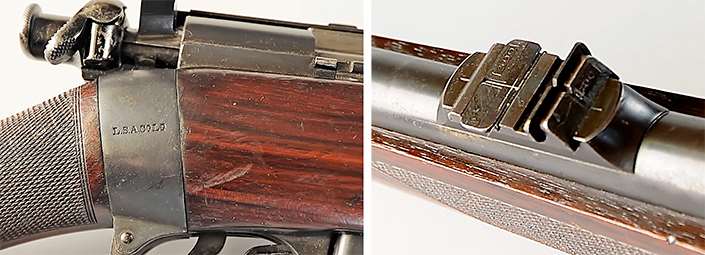
It’s certainly no secret that military rifles and military cartridges have been adapted to sporting use for a good number of years. In many cases, the sporters were created by amateur or professional gunsmiths out of existing surplus arms. In others, such as the stylish rifle we’re looking at here, they were actually made concurrently by the same factories producing the service-rifle originals.
In 1889, Great Britain introduced its first bolt-action repeating service rifle, the Lee-Metford Mark I. As well as being manufactured by government facilities at Enfield and Sparkbrook, contracts were let out to two private manufacturers, Birmingham Small Arms Co. (BSA) and London Small Arms Co. (LSA). The latter firms would continue building various incarnations of Lee-Metford and Lee-Enfield service arms through World War I. BSA began life in 1861, and, as well as arms, manufactured motorcycles, bicycles and military vehicles. It was acquired by Manganese Bronze Holdings in 1973. London Small Arms Co. was founded in 1866, first building Snider rifles, and would remain in business until 1935, solely in the firearm business.
While there is no question that James Paris Lee was the major influence on the series of rifles that bears his name, others also contributed various features, most notably the manager of the Enfield Royal Small Arms Factory, Joseph Speed. Speed took out a number of patents, but as an employee, received no additional remuneration for his efforts. Still, non-issue arms, such as hunting rifles and military arms intended for volunteer units often carried the legend “Lee-Speed Patents.” Because of that, the sporters have become generically known as Lee-Speeds, though they were normally retailed under other model designations, such as “No. 2” or “No. 4”, depending upon grade, features and configuration.

Both BSA and LSA manufactured sporting versions of the Lee-Enfield. While maintaining the basic mechanics of the Lee, the hunting rifles were sleekly civilianized with extra-quality half-stocks, engraving and checkering, superior finish and, usually, smaller, six-round magazines which would often be attached to the rifles by chained swivels. Other custom features—such as horn embellishments, sophisticated sighting arrangements and special thumb safeties—were not unusual.
While BSA was the major supplier of these rifles, which were also sold by a number of retailers such as the Army Navy Cooperative Society, Ltd., John Rigby & Co., and William Powell & Sons, it was generally conceded that rifles produced by LSA were of higher quality than those of BSA.
Not surprisingly, .303 British is the most commonly encountered chambering, but because of British government restrictions around the turn of the 20th century on the importation of service-caliber rifles—primarily into India and the Sudan—it became necessary to come up with an alternative.
Around 1907, BSA introduced a cartridge called .315 or 8 mm BSA. Though somewhat exotic sounding, it was really nothing more than an appropriately bulleted variant of the Austrian rimmed 8x50 mm military cartridge—so chosen because of the rimmed cartridge’s similarity to the .303. This meant little modification had to be made to the parent design. Ultimately, the load became quite popular in India and has been produced for decades in that country.
The rifle seen here is a high-grade LSA in 8 mm BSA. It has the added feature of sighting by Alexander Henry of Edinburgh, Scotland, and is so marked on the barrel. The checkered, walnut stock has a horn fore-end tip and pistol-grip cap. There is no engraving, but condition is excellent and the rifle is all-original. As such, it is worth a good, solid $2,500. If it had been chambered in .303 British, that figure could increase by at least $250.
Gun: Lee-Speed Sporting Rifle
Manufacturer: London Small Arms Co., Ltd.
Chambering: 8 mm (.315) BSA
Condition: NRA Excellent (Antique Gun Standards)
Manufactured: 1919
Value: $2,500



































